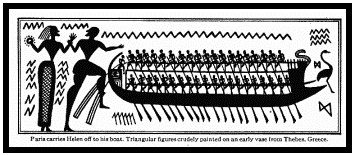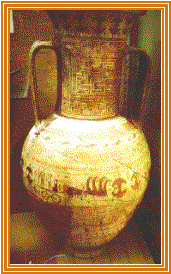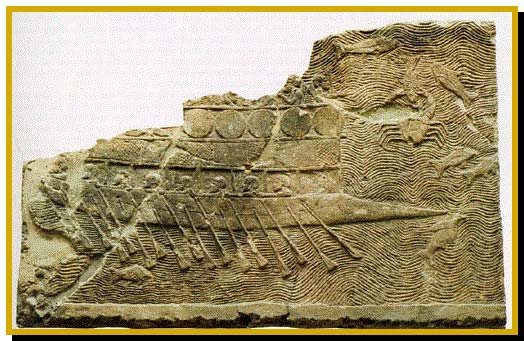Ancient Ships: The Ships of Antiquity
Ancient Ships in art history: Illustrations from Greek Pottery
of the History of Ancient Greece, the Greek Epic Poems and the Trojan
War

Illustrations of Themes from Classical Greek Literature
It is fortunate for sake of Greek history that verbal descriptions
of Bronze Age ships from ancient Greece abound in the stories of
Homer. However the identity of Homer is not entirely certain and
the stories which make up the Iliad and the Odyssey may be
the products of a long oral tradition of story telling in the ancient
Greek culture which were not committed to written text until as
late as the 6th Century BCE, however it is Homer who is criedited
to have committed these stories to their first written copies. Under
such circumstances  errors
and anachronisms might be expected to abound in accounts of events
that took place during the Trojan war as much as 600 years earlier.
For the practical historian it is noteworthy that in practice the
ships described in Homer appear to be carefully delineated from
those of the period in which the texts were actually written. For
example Homer never speaks of a ship of the Trojan war using a ram,
although the ram was a prominent feature of post 8th century BCE
Greek galleys, nor does he describe multi-banked galleys, which
are found in Greek ship iconography after the 8th century
BCE and before the Homeric poems were written. We can assume that
Homer was familiar with these elements of ship technology but did
not mention these features as part of the configuration of the ships
that were used during the Trojan Wars and its' period of Greek history. errors
and anachronisms might be expected to abound in accounts of events
that took place during the Trojan war as much as 600 years earlier.
For the practical historian it is noteworthy that in practice the
ships described in Homer appear to be carefully delineated from
those of the period in which the texts were actually written. For
example Homer never speaks of a ship of the Trojan war using a ram,
although the ram was a prominent feature of post 8th century BCE
Greek galleys, nor does he describe multi-banked galleys, which
are found in Greek ship iconography after the 8th century
BCE and before the Homeric poems were written. We can assume that
Homer was familiar with these elements of ship technology but did
not mention these features as part of the configuration of the ships
that were used during the Trojan Wars and its' period of Greek history.

Ship image from a late Geometric Krater circa 760-750 BC restored
in Photoshop
 The
true advantage that we have is that the artisans of the ancient
Greek culture often illustrated events similar to those that
are described in the stories written by the Greek poets. Similar
themes to those in the classical Greek Poems were frequently
painted on Vases and other ceramics starting as early as the Geometric
period 1600 BCE. The
true advantage that we have is that the artisans of the ancient
Greek culture often illustrated events similar to those that
are described in the stories written by the Greek poets. Similar
themes to those in the classical Greek Poems were frequently
painted on Vases and other ceramics starting as early as the Geometric
period 1600 BCE.
Later illustrations on Attic vases reflected classical
Greek Literary and mythological themes. Attic vases were containers
and can be thought of in many respects to be the first commercial
packaging with pictures on them. The artisans would take a utilitarian
item and decorate them with aspects of story lines from Greek culture.
For simple artistic reasonís few utilitarian items are richer in
their content than the Greek attic vases.
This decorative tradition was begun in the area
of Aegean Sea with the Minoan potters as early as 1700BCE.
It should be noted that the iconography of daily life was painted
on pottery and recorded as decorum in the culture long before
written records of the same activities began to occur as classical
Greek literature and poetry. This trend of the artisans illustrating
aspects of the Greek culture in which they lived in non textual
Iconographies prior to the introduction of formal writing systems
is true for cultures other that the Agean as well as the early Agean
Cultures. These illustrations within their archeoloical context
give archeologists and investigators the advantage of being able
to see and understand aspects of the culture of ancient Greece which
are not clearly delineated in the written records of
the Greek culture. 
Someone in their wisdom has said a picture is worth
a thousand words. In the case of the prehistoric cultures of the
Aegean Sea we often have a visual record that tells a story, all
you have to do is read the writing on the wall or pottery so to
speak, in order to see various aspects of the story of these prehistoric
Agean cultures.
The ships found in Homer are usually described as fast and hollow,
which means without a deck or open, long, narrow, low and light,
with black painted hulls. There were no accommodations for living
in them and they were built to be hauled onto a beach at night so
that the crews could camp on the shore. Speed and flexibility were
the premium with these boats. Gear was stowed under vestigial decks
at the stem and the stern. These are also features that were also
common to later Greek warships, most notably the trieres or trireme.
The key to the speed of and ability to navigate these
ships were the crews. Men on oars were the mechanism for maneuverability
and the wind in their sails was the primary motor for long
distance travel.
 Phoenician
Coin Phoenician
Coin
Homer classifies his ships into a number of well-defined types
that have no exact parallel in the ships of the 8th century. There
are, for example, small twenty oared galleys used for transport,
exploration or dispatch duties. The fifty oared pentecontor (25
oars per side) which was used as a troop carrier, and the larger
100 oared vessels (50) per side) which were used as heavy transports.
He does not anywhere in his writing mention the thirty-oared
triacontor, which was in common use in the eight century BC.

A Greek war ship from the time of the Persian wars Circa 600 BCE

Amphora
Pottery of the Cyclidic culture from Thera 1600 BCE demonstrates
the extensive use of iconography for decorative purposes within
the Aegean Cultures. These types of features were traditionally
used on pottery of the Aegean cultures, though they varied
in style and proficiency of execution, for the next 1400 years.
The images in this iconography gives us clues to cultural exchanges
that occurred which would be unavailable through the written
records. Much of the Iconography suggests several cultural
influences and where written records are not available are
the only means to do analysis of the social dynamics of the ancient
world.
 Where
shipbuilding is discussed in Homer, most obviously in the famous
passage from Calypso's island, Homer speaks in technological terms
such as keels, stem and sternposts, frames, planks, gunwales,
cross beams and through beams fastened with treenails and mortise
and tendon joints fabricated from a variety of preferred woods
including oak, poplar, pine and fir. These methods of construction
were certainly common in the eight century and had probably developed
from similar methods used in the previous millennium. One of the
best records of ship iconography from this historic era are those
recorded by the Egyptians during the Invasion of the Sea peoples
into Egypt during approximately the same time period of 1200 BCE. Where
shipbuilding is discussed in Homer, most obviously in the famous
passage from Calypso's island, Homer speaks in technological terms
such as keels, stem and sternposts, frames, planks, gunwales,
cross beams and through beams fastened with treenails and mortise
and tendon joints fabricated from a variety of preferred woods
including oak, poplar, pine and fir. These methods of construction
were certainly common in the eight century and had probably developed
from similar methods used in the previous millennium. One of the
best records of ship iconography from this historic era are those
recorded by the Egyptians during the Invasion of the Sea peoples
into Egypt during approximately the same time period of 1200 BCE.
An overview of iconography from the eastern
Mediterranean would suggest that the ship building technologies
were know and shared between cultures. The Egyptians were
known to have sought the support of ship builders and traded
for timbers for ship building from Byblos as early as the construction
of the Pyramid complex of the Pharaoh Sahure 2450 BCE.
This would explain the projecting forefoot,
not at this stage a ram, which is characteristic of the limited
iconography for this period, particularly the Pylos vase and the
Gazi Larnax as having derived from Egyptian ships which prominently
featured these characteristics as early as 1250 BCE.
Illustration of Ships form the time of the Iliad, see
similar images on Greek attic pottery at the Perseus
Project
 The
oars in Homeric galleys were rowed against thole pins and held in
place by a leather strap. Only one steering oar was used , again
this is consistent with the twelfth century Mycenaean iconography,
and also with the ships illustrated in Thera Frescos from the 16
th Century BCE. Twin steering oars were standard by the 6th
century. Where sails are described the mast was usually dismountable
and was set in the tabernacle above the keel and held in place by
two forestays and one backstay without shrouds. A single loose-footed
square sail was used made up of patches of linen. Standing rigging
included braces to the yardarm, sheets, and brailing lines. Homeric
ships were also expected to carry lines and stone anchors, and they
may have been equipped with bilge drain plugs to facilitate and
drying out the boats after beaching. The
oars in Homeric galleys were rowed against thole pins and held in
place by a leather strap. Only one steering oar was used , again
this is consistent with the twelfth century Mycenaean iconography,
and also with the ships illustrated in Thera Frescos from the 16
th Century BCE. Twin steering oars were standard by the 6th
century. Where sails are described the mast was usually dismountable
and was set in the tabernacle above the keel and held in place by
two forestays and one backstay without shrouds. A single loose-footed
square sail was used made up of patches of linen. Standing rigging
included braces to the yardarm, sheets, and brailing lines. Homeric
ships were also expected to carry lines and stone anchors, and they
may have been equipped with bilge drain plugs to facilitate and
drying out the boats after beaching.

Phoenician Ship From 800 BCE Stone Relief Sculpture

The Argo
Argo was the name of a Greek navigation system.
 The
Argo was built near Pelion Mount most possibly at Pagasses. The
story of the Argos is pure high adventure. The men who took
part in the expedition were called Argonautae or Minyas, and the
journey was the Argonautica Expedition or the Argonautica. The
Argo was built near Pelion Mount most possibly at Pagasses. The
story of the Argos is pure high adventure. The men who took
part in the expedition were called Argonautae or Minyas, and the
journey was the Argonautica Expedition or the Argonautica.
The shape of the ship was oblong and this is the
reason for giving her the name "the long vessel", as well.
It was the first long vessel as, until that time, the Greeks
had been using mostly small round-shaped ships. Some sources
say that the Argo was a fifty-oared ship while some others say that
there were thirty oars on each side. Hence, they estimate that the
Argo's length must have been between 22 or 25 meters. The wood that
was used was probably oak and pine. The Argo was equipped with all
those implements and tacking necessary for the management and guiding
of the ship. It was a hard constructed ship, able to sail in open
seas and stand up well to the blows of huge waves.
 Although
the Argo - and most prehistoric Hellenic ships - had no engine,
she had a great advantage compared to the ships of today. The ship
would not need a port to call at. Because of her low draught she
could be hauled ashore at the convenience of the crew as weather
or other circumstances may have demanded. Although
the Argo - and most prehistoric Hellenic ships - had no engine,
she had a great advantage compared to the ships of today. The ship
would not need a port to call at. Because of her low draught she
could be hauled ashore at the convenience of the crew as weather
or other circumstances may have demanded.
Because she had to be hauled up the beach in order
to avoid possible destruction by a sea-storm, the Argo did not have
a deck as its additional weight would render her hauling more difficult
or impossible. The ability to haul ashore was a great advantage
of the prehistoric Hellenic vessels, which made possible the accomplishment
of those amazing and incredible explorations made at that time.
At the prow of the ship Athena fitted in a "speaking"
timber from the oak of Dodona, which would advise the Argonauts
on the right course. In fact, that "speaking " timber
("Koraki" in the Hellenic nautical terminology) operated
like a compass, and it corresponded to the North while the steering
oar ("Diaki" in the Hellenic nautical terminology) to
the South. The imaginary line between the steering oar and the "speaking"
timber extended towards a certain point of the horizon-which was
determined by the positions of stars (I.E. the Pole Star)- enabled
the Captain to trace the course of the ship approximately
Fortunately for the person interested in this period
of Greek history even quite small boats represent a considerable
expenditure of labor and wealth and required a high degree of organization
to navigate and operate. Boats  therefore were usually valuable and prized objects in the societies
that produced them. Boats are also relatively large structures.
Indeed they are still probably the largest moving objects made by
man and for this reason alone ships and boats have imposed
themselves on the imaginations of artists and story tellers from
the earliest times to the present day. We are fortunate to have
pictures of ships appear in many forms and in many different places.
therefore were usually valuable and prized objects in the societies
that produced them. Boats are also relatively large structures.
Indeed they are still probably the largest moving objects made by
man and for this reason alone ships and boats have imposed
themselves on the imaginations of artists and story tellers from
the earliest times to the present day. We are fortunate to have
pictures of ships appear in many forms and in many different places.
The formulation of crews to man the ships represented
a major commitment and effort to create team work, all involved
knowing they were dependent on one another for the ultimate success
of the voyages.
Where societies were particularly reliant on ships
for trade and war the ship became an important part of the culture,
perhaps a dominant part as in the case of the Egyptians, Phoenicians,
Greeks and the Vikings. Traditionally and by definition the seafaring
boat and ship has been identified with trading enterprises and exploratory
adventures into the unknown and in some cultures it was associated
with the ultimate voyage from life to death, which is why boats
find their way into Egyptian pyramids and the graves of Saxon and
Viking nobles. From antiquity to the Renaissance the ship became
the vehicle for exploration and discovery into Africa and the Known
World. In this role, too, ships and boats have appealed to the artist
and cultural historian.
Fortunately representations of ships are widespread
throughout recorded history. How accurate these pictures are is
another matter, depending on the cultural attitudes and technical
competence of the artists. Ship iconography as found on artifacts
is beset with distortions however the images remain from antiquity
giving us critical and credible clues to the use and evolution of
ships and boats in various cultures.
Fortunately modern archeology is allowing us to
fill in some of the blanks as deep water finds are revealing additional
information on ship building technologies and trade associations.

A Greek crew setting ashore
Compare this image to the Original
on a Greek vase dated 540BCE
Greek history
An
outlined study of Greek Colonization in the Mediterranean
from the time of the Trojan Wars 1200 BCE
to The time of Alexander the Great 300 BCE
Previous |
Next | Table Of Contents
|
